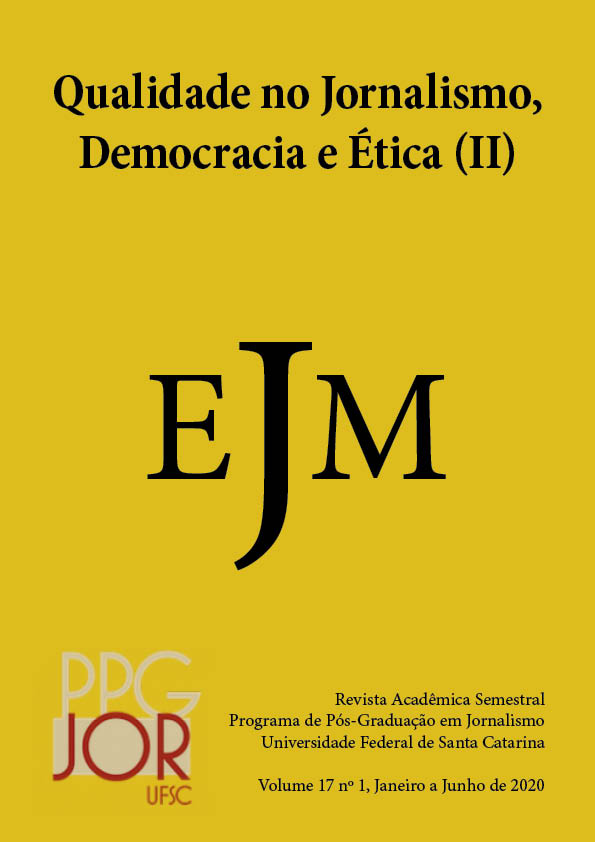Buster Keaton as the cameraman: cinema and journalism represented as spectacle
DOI:
https://doi.org/10.5007/1984-6924.2020v17n1p131Abstract
This article analyzes Edward Sedgwick’s The Cameraman (1928), starring Buster Keaton, to reflect on how journalism is represented as a media spectacle. Bearing in mind the historical and cultural context in which the movie was produced and released, the end of silent film, and through analysis of narrative and filmmaking procedures, our aim is to show how the metacinema found in The Cameraman sheds light on the making of the newsreel, with the character, acting as reporter and cameraman, also taking an active part in creating the journalistic event, which is then converted into so-called “documentary” images in the newsreel version. At the same time, the movie disconcertingly employs the boy-meets-girl formula throughout the plotline of the main character’s professional ascension in the field of journalism as an expression of modern times, in which he acts as a filmmaker and becomes a character in his own journalistic narrative.
References
ALSAESSER, Thomas (org.). Early cinema: space, frame, narrative. London: FBI Publishing, 1990.
BORDWLL, David. Sobre a história do estilo cinematográfico. Campinas: Unicamp, 2013.
BRIGGS, Asa; BURKE, Peter. Uma história social da mídia: de Gutenberg à Internet. Rio de Janeiro: Jorge Zahar, 2006.
BULHÕES, Marcelo. Jornalismo e literatura em convergência. São Paulo: Ática, 2007.
CHARNEY, Leo; SCHWARTZ, Vanessa R. (orgs.). O cinema e a invenção da vida moderna. São Paulo: Cosac Naify, 2004.
COUSINS, Mark. História do cinema: dos clássicos mudos ao cinema moderno. São Paulo: Martins Fontes, 2013.
DEBORD, Guy. A sociedade do espetáculo. São Paulo: Contraponto, 1997.
MACHADO, Arlindo. Pré-cinemas e pós-cinemas. Campinas: Papirus, 1997.
MASCARELLO, Fernando (Org.). História do cinema mundial. Campinas: Papirus, 2006.
MARTIN, Marcel. A linguagem cinematográfica. São Paulo: Brasiliense, 2007.
ROSENFELD, Anatol. Cinema: arte e indústria. São Paulo: Perspectiva, 2009.
PARKINSON, David. History of film. New York: Thames and Hudson, 1995.
SABADIN, Celso. Vocês ainda não ouviram nada: a barulhenta história do cinema mudo. São Paulo: Summus, 2009.
STAM, Robert. O espetáculo interrompido: literatura e cinema de desmistificação. Rio de Janeiro: Paz e Terra, 1981.
STEPHENS, Mitchell. A history of news. New York: Penguin Books, 1988.
TRAQUINA, Nelson. Teorias do jornalismo: por que as notícias são como são. Florianópolis: Insular, 2005.
VIRILIO, Paul. Guerra e cinema. São Paulo: Scritta, 1993.
Downloads
Published
Issue
Section
License
Ao encaminhar textos à revista Estudos em Jornalismo e Mídia, o autor estará cedendo integralmente seus direitos patrimoniais da obra à publicação, permanecendo detentor de seus direitos morais (autoria e identificação na obra), conforme estabelece a legislação específica. O trabalho publicado é considerado colaboração e, portanto, o autor não receberá qualquer remuneração para tal, bem como nada lhe será cobrado em troca para a publicação. As ideias e opiniões expressas no artigo são de exclusiva responsabilidade do autor, não refletindo, necessariamente, as opiniões da revista. Citações e transcrições são permitidas mediante menção às fontes. A revista Estudos em Jornalismo e Mídia está sob a Licença Creative Commons



